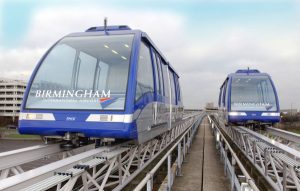What does obsolesence, trains, and Embedded World 2012 have in common?

The low-speed Birmingham International Airport maglev shuttle was in operation for less than eleven years before obsolescence problems made it inoperable.
I must admit, I’m looking forward to the upcoming Embedded World 2012 presentation on Model Based Design and Testing of Embedded Systems for the Train & Transportation Industry by Franck Corbier, with Dassault Systèmes.
Why? Because I have an old-fashioned side of me that loves nothing more than hours on a train, traveling across country.
The first successful locomotives were built by Richard Trevithick, in 1804. Since then the train and railway systems has been an invaluable resource when it comes to transporting passengers and heavy commercial loads across towns, cities and even nations. And with the emergence of embedding computing technology, everything from train operation, to signaling, to track switching relies on ever growing embedded systems that few of us ever think about.
In countries like France and Britain, it isn’t unusual to see 30-50 year old legacy systems that need to be maintained, being integrated with increasingly more sensitive and sophisticated systems with significantly shorter life-cycles.
Such a life-cycle issues brought the world’s first commercial automated maglev system to a halt. Between 1984–1995, the low-speed maglev shuttle ran between Birmingham International Airport and the Birmingham International railway station. While a significant technological advancement, it was in operation for less than eleven years before obsolescence problems with the electronic systems made it inoperable
The growing cost of designing electrical systems often doesn’t consider the risk that readily available COTS hardware may go end-of-life. Train builders, operators and their suppliers, are being called on to develop and deliver high quality services and embedded systems while meeting increasingly stringent certification constraints. At the same time, it’s a near certainty parts won’t be available after 10 years…unless they make proactive arrangements.
Like never before, it is essential to develop a long-term support plan to resolve future system longevity issues. With a railway industry that is competing with thriving trucking, automotive, aviation, and shipping industries (both in commercial and passenger sectors), the railway industry can’t afford to re-certify an embedded system that potentially crosses international lines, every time a critical board goes EOL.
Looking forward to Embedded World, and who knows.. maybe some new insight on railway legacy.
Warmly,
Kaye & The GDCA Team




